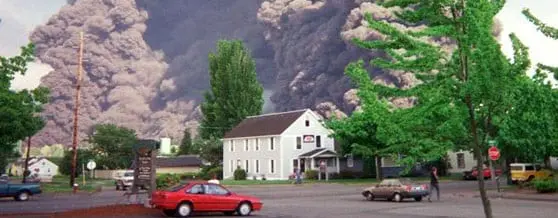On June 10, 1999, an Olympic Pipe Line Company pipeline in Whatcom Falls Park ruptured and spilled approximately 237,000 gallons of gasoline into Hanna and Whatcom Creeks. The resulting explosion consisted of a fireball which raced 1.5 miles down Whatcom Creek and created a smoke plume 20,000 to 30,000 feet high.
Three people were tragically killed – two ten-year old boys, Wade King and Stephen Tsiorvas, and an 18-year-old young man, Liam Wood, who was fishing in Whatcom Creek. Eight people were injured, and extensive damage incurred over the 1.5-mile length of Whatcom Creek.
Read more about the tragedy in Whatcom Creek Pipeline Explosion: A Decade of Healing or watch the videos below:
- Disaster Bellingham Video (2009)
- Community Remembrance Gathering – Remembering 25 Years – June 10, 2024 Video Recording
- Voices of the Whatcom Creek Pipeline Explosion Video Series
Environmental impacts
Approximately 26 acres of trees and vegetation were burned during the incident, including 16 acres of mature second-growth forest within Whatcom Falls Park and 10 acres of third- or fourth-generation floodplain forest and meadow west of the park. Within an hour of the fire, a City crew placed absorbent containment booms in the creek in an attempt to protect the lower part of Whatcom Creek from contamination.

Fish and wildlife impacts were impossible to fully quantify. Field staff did collect or observe more than 100,000 dead salmon, trout, lamprey, and crayfish in the days following the fire. Scientists concluded that all aquatic life in three miles of Whatcom Creek was killed through direct contact with the fuel or fumes, or when the fuel ignited.
Response
The City joined a consortium of western Washington cities to demand more rigorous inspection and oversight of all pipelines in urban areas. Former Mayor Mark Asmundson visited Washington, D.C. and delivered remarks during a U.S. Senate hearing on October 27, 1999.
The Bellingham community – including the families impacted by the tragedy – came together in response to the incident to form a group that ultimately became the Pipeline Safety Trust, an educational and advocacy group that works for greater pipeline safety nationwide. The creation of the Trust was funded by fines imposed on the pipeline industry.
On-the-ground response to the pipeline tragedy was carried out under the federal Oil Pollution Act, Washington’s Water Pollution Control Act, and Oil and Hazardous Substance Spill Prevention and Response Act. An oversight board, called the Natural Resource Trustees, was established; its members include: the United States Department of Commerce as represented by the National Oceanic and Atmospheric Administration; the United States Department of the Interior as represented by the United States Fish and Wildlife Service; the State of Washington as represented by the Department of Ecology; the City of Bellingham; the Lummi Nation; and the Nooksack Indian Tribe.
The Trustees and the Olympic Pipeline Company established a fund of $500,000 that funded long-term monitoring and maintenance activities related to this incident through 2020. Long-term monitoring and maintenance support is now included as part of the City’s operational budget using a variety of funding sources.
Restoration efforts
Within the first week of the incident, former Washington State Governor Gary Locke appointed the City as the administrative lead of the restoration trustees because the City had staff with expertise in environmental restoration and much of the damage occurred on City property.
The City established the Monitoring and Maintenance Plan Associated with the Whatcom Creek Restoration Plan Developed for the June 10, 1999 Olympic Pipe Line Gasoline Spill (Plan) in 2006 for early restoration projects. The purpose of the Plan was to create protocols for documenting environmental recovery, evaluating long-term performance, and providing a routine for appropriate maintenance activities using an adaptive management approach. Early projects include those on Cemetery Creek and Salmon Park. As required in the 2006 Plan, the City monitored the Cemetery Creek and Salmon Park restoration sites for a period of 10 years. Monitoring began in 2007 after project construction and continued through 2016.
The following reports are available:
- Whatcom Creek Restoration Project Final Monitoring Report, Final 10-Year Monitoring Results (PDF)
- Whatcom Creek Post-Fire Evaluation – 10 Years After (PDF)
- Whatcom Creek Ten-Years After Summary Report (PDF)
- Whatcom Creek Restoration Project Report (PDF)
Resources
- Whatcom Creek Pipeline Explosion: A Decade of Healing
- Pipeline Safety Trust History
- Disaster Bellingham Video (2009)
- Community Remembrance Gathering – Remembering 25 Years – June 10, 2024 Video Recording
- Voices of the Whatcom Creek Pipeline Explosion Video Series
- Former Bellingham Mayor Mark Asmundson’s Remarks at U.S. Senate Hearing – October 27, 1999
- City Restoration Sites
Contact
Please contact the Public Works Department for more information.

